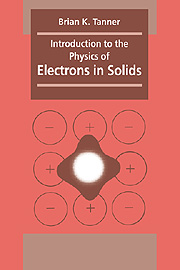Book contents
- Frontmatter
- Contents
- Preface
- Acknowledgements
- 1 The classical free electron model
- 2 Quantum mechanical free electron model
- 3 Application of the Fermi gas model
- 4 Energy bands
- 5 Experimental evidence for band structure and effective mass
- 6 Electrical conduction in semiconductors and insulators
- 7 Semiconductor devices
- 8 Localized electrons
- 9 Magnetism
- 10 Superconductivity
- Appendix 1 Elements of kinetic theory
- Appendix 2 Elements of statistical mechanics
- Appendix 3 Derivation of the Landé g factor
- Index
- Frontmatter
- Contents
- Preface
- Acknowledgements
- 1 The classical free electron model
- 2 Quantum mechanical free electron model
- 3 Application of the Fermi gas model
- 4 Energy bands
- 5 Experimental evidence for band structure and effective mass
- 6 Electrical conduction in semiconductors and insulators
- 7 Semiconductor devices
- 8 Localized electrons
- 9 Magnetism
- 10 Superconductivity
- Appendix 1 Elements of kinetic theory
- Appendix 2 Elements of statistical mechanics
- Appendix 3 Derivation of the Landé g factor
- Index
Summary
We have until now made use of the independent electron approximation, in which it is assumed that we can treat each electron independently of all of the others. In this chapter we will examine the consequence of the breakdown of this phenomenon.
It has been known for centuries, indeed it was known to the ancient Chinese, that magnetite or lodestone was attracted by the earth's field. Two pieces of lodestone attracted or repelled each other depending on which end of the lump of rock was pointed at the other. These chunks of material possess a spontaneous magnetic moment, i.e. they have a magnetization in zero external magnetic field.
We find that the elements iron, nickel and cobalt, bunched together in the middle of the periodic table, can also be induced to have a spontaneous moment at room temperature. The spontaneous magnetization M (defined as the magnetic moment per unit volume) is very large compared with that induced by a magnetic field in materials such as copper or zinc, which are very close in the periodic table. Alloys of iron, cobalt and nickel also have such properties which became known as ferromagnetism.
Basic phenomena
Hysteresis loops
Ferromagnetic materials show a characteristic M – H (or M – B0) loop. The susceptibility, defined by k = M/B0 where B0 is the external field, is very large and the magnetization displays hysteresis (Fig. 9.1). In sufficiently high field the magnetization saturates, this saturation magnetization being a characteristic of the material.
- Type
- Chapter
- Information
- Introduction to the Physics of Electrons in Solids , pp. 181 - 212Publisher: Cambridge University PressPrint publication year: 1995



